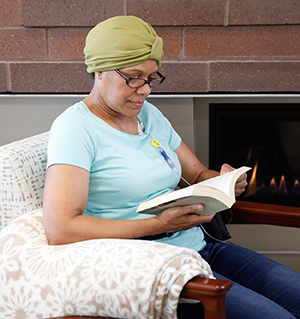Cervical Cancer: Chemotherapy
What is chemotherapy?
Chemotherapy (chemo) uses strong medicines to kill cancer cells. The medicines attack and kill cells that grow quickly, like cancer cells. Some normal cells also grow quickly. Because of this, chemotherapy can harm those cells. This can cause side effects.
When might chemotherapy be used for cervical cancer?
Chemotherapy is usually given along with radiation for cervical cancer. It helps the radiation work better. This is called chemoradiation. Chemo may be used on its own to treat cervical cancer that has spread to other parts of the body or has come back after treatment.
How is chemotherapy given for cervical cancer?

Chemo is most often put right into your blood through an IV. It may also be taken by mouth as a pill or as an injection (shot). It may be given at your healthcare provider's office, a chemo clinic, or at a hospital infusion center. So you go home the same day. It's rare to stay in the hospital for treatment.
You get chemo in cycles over a period of time. That means you may take the medicine for a set amount of time and then you have a rest period. Each period of treatment and rest is one cycle. You may have several cycles. Having treatment in cycles helps by:
-
Killing more cancer cells. Chemo kills cells that are dividing quickly. Cancer cells aren't all dividing at the same time. So giving treatments in cycles allows the medicine to fight more cells.
-
Giving your body a rest. Treatment is hard on other cells in your body that divide quickly. This includes cells in the lining of your mouth and stomach. This causes side effects, like sores and nausea. Between cycles, your body can get a rest and heal.
-
Giving your mind a rest. Getting chemo can be stressful. Rests between cycles can let you get an emotional break between treatments.
Chemo is commonly given every 3 to 4 weeks. But schedules vary. Your healthcare provider will review the schedule with you based on the chemo medicines used for your treatment.
You may get radiation therapy at the same time as chemotherapy. This is because chemo can help radiation therapy work better. In this case, you may get chemo weekly.
What are the types of medicines used to treat cervical cancer?
Chemo for cervical cancer is usually done with a combination of medicines that are given into an IV. These are some of the medicines most often used:
-
Cisplatin
-
Carboplatin
-
Paclitaxel
-
Topotecan
-
Gemcitabine
-
Fluorouracil (5-FU)
What are common side effects of chemotherapy?
Chemo side effects depend on the type and dose of medicines you're taking. They tend to be worse when radiation and chemo are given at the same time. But they vary from person to person. Here's a list of common side effects:
-
Appetite loss
-
Bruising and bleeding easily
-
Nerve damage (peripheral neuropathy)
-
Diarrhea
-
Feeling very tired (fatigue) or having less energy
-
Hair loss
-
Increased chance of infections
-
Mouth sores
-
Nausea and vomiting
-
Skin changes
-
Shortness of breath
-
:Kidney damage
-
Hearing problems
-
Menstrual changes or infertility
Many of these side effects can be controlled. And most will go away or get better between treatments. Some may last longer or be permanent. Tell your healthcare provider or nurse about any changes or side effects that you notice. There may be things you can do or medicines you can take to manage them. Most side effects go away over time after your treatments end.
Working with your healthcare team
It's important to know which medicines you're taking. Write down the names of your medicines. Ask your healthcare team how they work, what they're for, and what side effects they might have.
Talk with your healthcare providers about what signs to look for and when to call them. For instance, chemo can make you more likely to get infections. Your healthcare provider will likely want you to call if you have signs of infection, such as:
-
Burning during urination
-
Fever of 100.4°F (38°C) or higher, or as advised by your healthcare provider
-
New cough or shortness of breath
-
Redness, swelling, and warmth at the site of an IV or injury
-
Shaking chills
-
Sore throat
Make sure you know what number to call with questions. Is there a different number for evenings, holidays, and weekends?
It may be helpful to keep a diary of your side effects. Write down physical, thinking, and emotional changes. A written list will make it easier for you to remember your questions when you go to your appointments. It will also make it easier for you to work with your healthcare team to make a plan to manage your side effects.